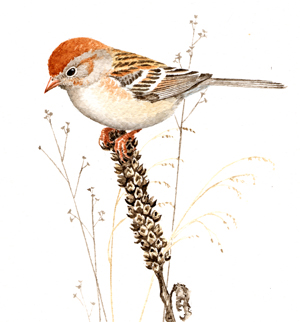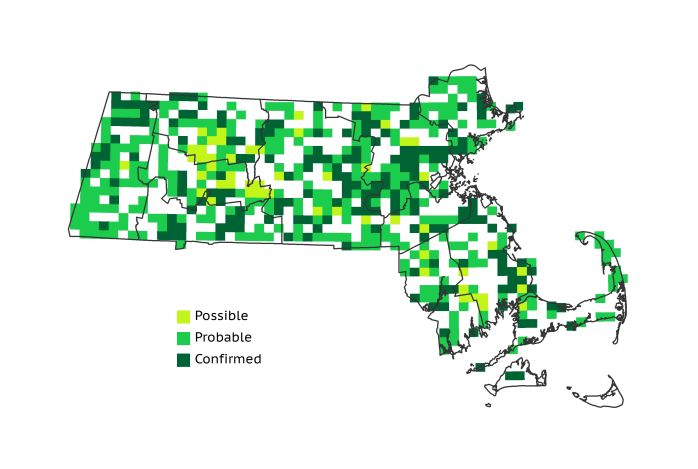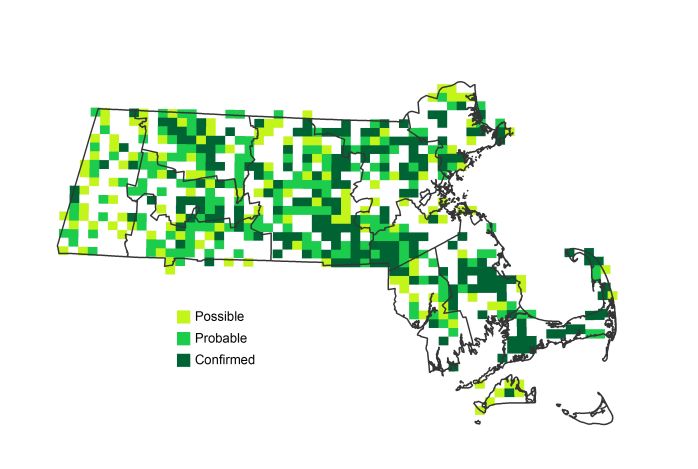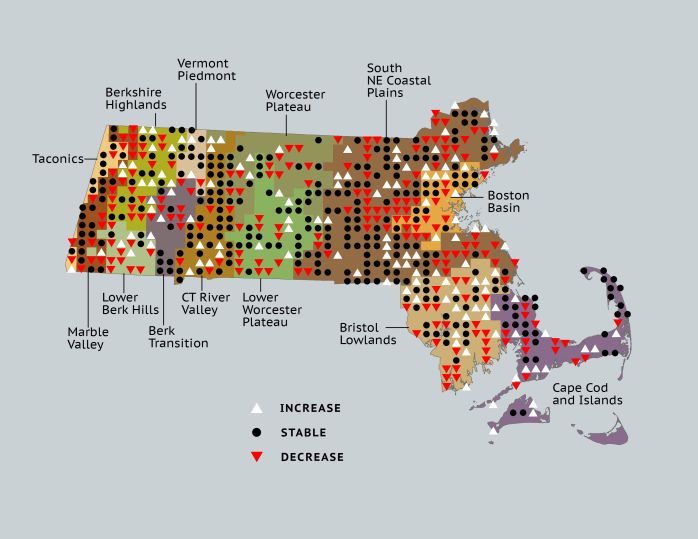Find a Bird
Field Sparrow
Spizella pusilla

Widespread and likely declining
Action/monitoring needed
State Wildlife Action Plan listed
"This morning, in the fresh field, I came upon a hidden nest. It held four warm, speckled eggs.” – Mary Oliver, “With Thanks to the Field Sparrow, Whose Voice is so Delicate and Humble”
The unmistakable accelerating song of the Field Sparrow (often likened to a bouncing ball) conjures up images of broad, brushy meadows carpeted with grass blowing gently in the summer breeze. As the breeze subsides, a small brown bird flutters from the top of a shrub over to a seed-laden flower head, where it lands and allows its weight to bend the stalk, carrying its prize down to the ground to be eaten. Such a sight is not as common in Massachusetts as it once was, and while Field Sparrows can still be found across the Commonwealth in areas where appropriate shrubland habitat remains, they, like many of their fellow old field and shrubland breeders, are sending us an unmistakable signal.
Historic Status
Every April in the first half of the nineteenth century, Massachusetts farmers could expect the arrival of the Field Sparrow. Tied to fields and pastures, the species thrived in the state during the great agricultural era, but during the latter half of the nineteenth century, the picture changed. Many Massachusetts farms were abandoned in favor of more fertile lands to the west during that time, so eventually many of these Massachusetts farmsteads began reverting back to forests. This process accelerated during the twentieth century, and soon local Field Sparrow populations began to diminish. Described by Forbush as, “by no means such domestic birds as the Chipping Sparrows” (Forbush 1929), the species appeared not to take well to suburbanization, either, which ultimately became another likely factor contributing to its slow decline (Veit & Petersen 1993).
Atlas 1 Distribution
Field Sparrows will utilize a variety of open habitats, and were accordingly still widespread during Atlas 1, posting block occupancy of 56%. Their bouncing-ball song was heard throughout the western regions, with the lowest occupancy in the Lower Berkshire Hills, and the highest block occupancy (90%) in the Marble Valleys. The Connecticut River Valley was replete with old fields and active brushy pastures, both of which were well suited to the Field Sparrow. The species readily made itself at home in forest clearings and other openings in the Lower Worcester Plateau, occupying over 60% of the blocks there, but were somewhat rarer in the north. The Coastal Plains supported 64% block occupancy, owing to the many old farm fields and cut-over woodlots that dotted the rapidly suburbanizing landscape. The sparrows were less dominant but still present from the Boston Basin ecoregion out to the Cape and Islands, but absent from Nantucket.
Atlas 2 Distribution and Change
While many ecoregions witnessed interesting internal population shifts (for example, Cape Cod lost Field Sparrows from 15 blocks, but found them anew in 15 others), a handful of regions showed dramatic declines in the number of Field Sparrows present. The Marble Valleys, Coastal Plains, and Lower Worcester Plateau had notable net losses, contributing to an overall decline of 6% block occupancy across the state, bringing their statewide occupancy to 50%. Looking at the effort-controlled data, the declines are even steeper, with a trend of -8% in the species’ footprint statewide. The species’ absence in these areas is most likely indicative of the loss of their breeding habitat to returning forests or to suburbanization.
Atlas 1 Map

Atlas 2 Map

Atlas Change Map

Ecoregion Data
Atlas 1 | Atlas 2 | Change | ||||||
Ecoregion | # Blocks | % Blocks | % of Range | # Blocks | % Blocks | % of Range | Change in # Blocks | Change in % Blocks |
Taconic Mountains | 11 | 68.8 | 2.0 | 11 | 44.0 | 2.1 | -2 | -13.3 |
Marble Valleys/Housatonic Valley | 35 | 89.7 | 6.5 | 21 | 53.8 | 4.0 | -14 | -35.9 |
Berkshire Highlands | 31 | 56.4 | 5.7 | 30 | 54.5 | 5.7 | -2 | -3.8 |
Lower Berkshire Hills | 13 | 46.4 | 2.4 | 7 | 22.6 | 1.3 | -6 | -22.2 |
Vermont Piedmont | 12 | 70.6 | 2.2 | 15 | 88.2 | 2.9 | 1 | 8.3 |
Berkshire Transition | 20 | 52.6 | 3.7 | 17 | 42.5 | 3.2 | -4 | -12.9 |
Connecticut River Valley | 43 | 76.8 | 7.9 | 50 | 76.9 | 9.5 | 2 | 4.2 |
Worcester Plateau | 36 | 46.2 | 6.6 | 45 | 51.1 | 8.6 | -4 | -8.3 |
Lower Worcester Plateau | 47 | 63.5 | 8.7 | 43 | 53.8 | 8.2 | -10 | -18.5 |
S. New England Coastal Plains and Hills | 172 | 63.7 | 31.7 | 161 | 56.9 | 30.7 | -26 | -11.5 |
Boston Basin | 25 | 44.6 | 4.6 | 25 | 44.6 | 4.8 | 0 | 0.0 |
Bristol and Narragansett Lowlands | 51 | 48.1 | 9.4 | 48 | 42.1 | 9.1 | -4 | -4.0 |
Cape Cod and Islands | 46 | 33.8 | 8.5 | 52 | 36.1 | 9.9 | 0 | 0.0 |
Statewide Total | 542 | 55.9 | 100.0 | 525 | 50.6 | 100.0 | -69 | -8.3 |
Notes
In accordance with Atlas decreases, Field Sparrows show significant decreasing Breeding Bird Survey trends in Massachusetts, in the New England/Mid-Atlantic Region, and in the Eastern US overall.



